|
|
|||||
|
|
|
|
|
||
| . | |||||
|
 |
|
|
|||||
|
|
|
|
|
||
| . | |||||
|
 |
. |
Nineteen sixty-three was the first of a string of four consecutive years in which the Buffalo Bills participated in post-season play, the only American Football League team to accomplish that feat. They lost the 1963 AFL Eastern Division playoff to their arch-rivals, the Boston Patriots. But that taste of post-season action served them well, and they came back to make 1964 their first championship year, defeating the favored San Diego Chargers 20-7. In 1965, the same two teams met for the championship, this time on the Chargers' home field. The Bills' 1964 victory was discounted by some as a fluke, or as the result of the loss of the Chargers' Keith Lincoln early in the game. In the 1965 Championship game the Bills, now without Cookie Gilchrist, were again the underdog. But the 1965 Bills showed that they were as formidable a team as the previous year's squad. This page is a tribute to that 1965 team. . |
. |
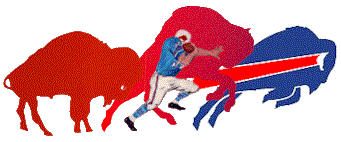 |
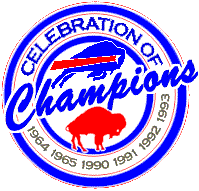 |
|
The Bills wore
throwback jerseys
from the 1964 and 1965 Championship years for two games in 2005. |
|
. |
|
||
. |
| Note: The football cards reproduced below are from the 1966 Topps set, but the photos and uniforms shown on these cards were from 1965 or earlier. Click on the photo for a larger image or click on the player's name for a view of the back of the card. |
. |
Click on images or clippings for a larger view |
. |
|
|
. |
|
|
||
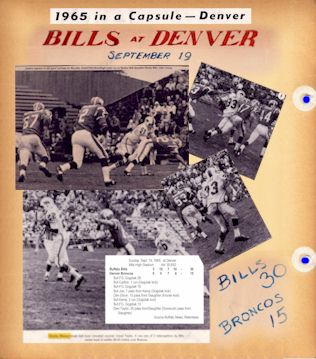 |
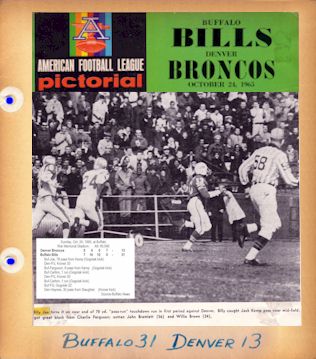 |
. |
|
||
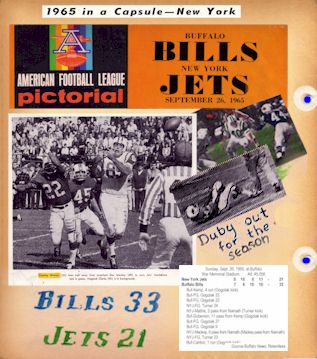 |
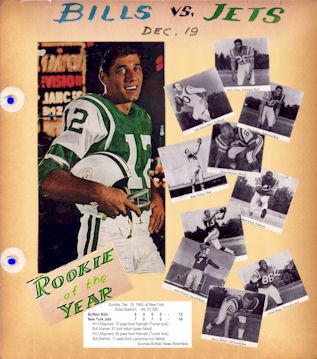 |
...... |
|
|
||
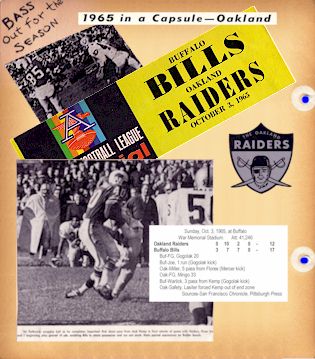 |
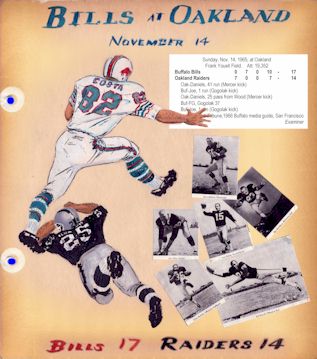 |
...... |
|
|
||
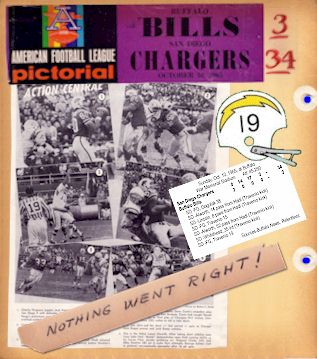 |
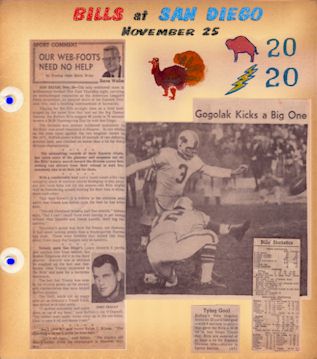 |
|
||
|
...... |
|
|
||
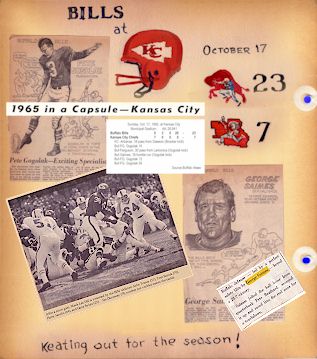 |
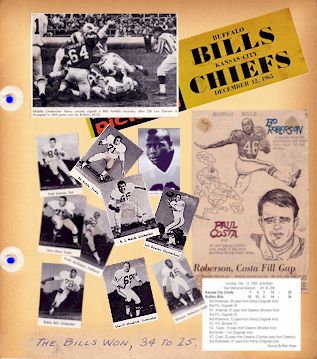 |
...... |
|
|
||
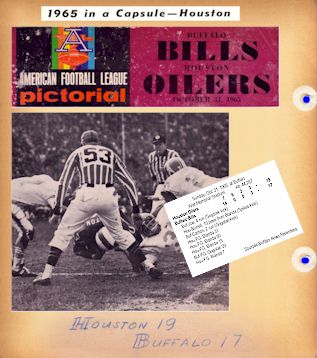 |
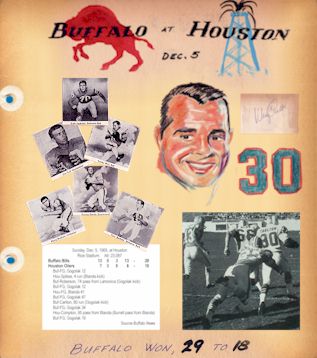 |
...... |
|
|
||
|
...... |
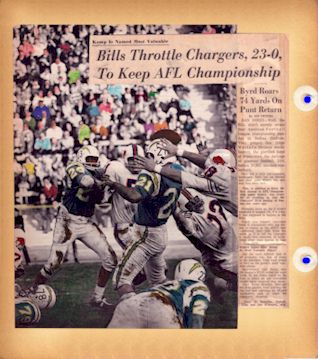 |
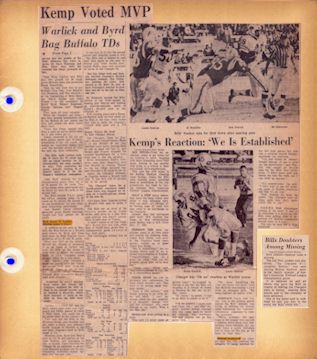 |
||
|
|
...... |
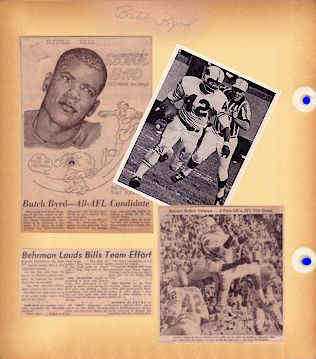 |
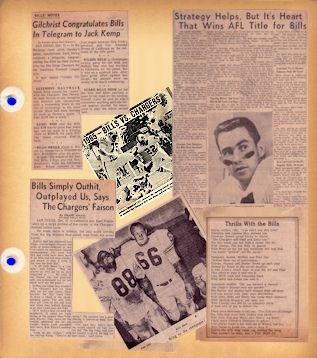 |
||
|
|
...... |
More to come ~ last update 19 December 2024 |
Photo Courtesy of Denny Lynch, Buffalo Bills Archivist |
||||||||||
...... |
|
1965 Buffalo Bills |
|
|
|
...... |
|
Remi Prudhomme, a 1965 Bills draft choice, was injured for the entire 1965 season and didn't play a game. However, he was such a hard worker, and so popular, that the Bills voted him an AFL Championship ring. He later earned a 1969 AFL Championship and a World Championship ring with the Kansas City Chiefs. |
||
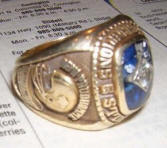 |
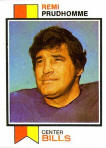 |
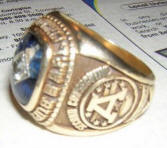 |
|
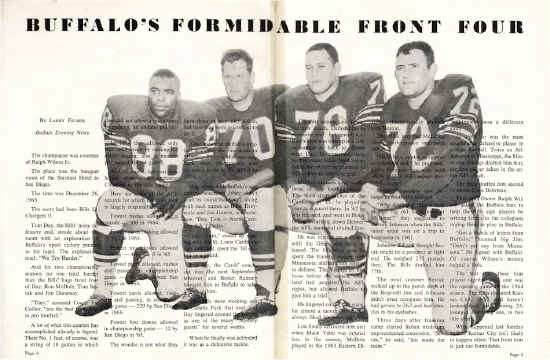 |
|||
|
. |
| The 1965 Buffalo Bills continued the on-field excellence of the previous year. Their defense extended a string that began in the 1964 season, to seventeen straight games without allowing an opponent to score a rushing touchdown. Two members of the 1965 squad were eventually named to the American Football League's All-Time Team, five to the second team, and fifteen are in the American Football League Hall of Fame. The only player ever inducted to the "pro football" hall of fame, without ever playing in the NFL, was a member of the 1965 Bills; guard Billy Shaw. |
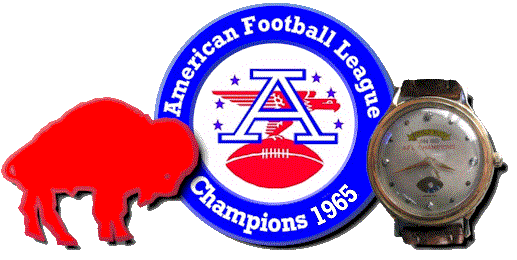
. |
|
.. |
1965 League Leaders
Field goals made:
Pete Gogolak – 28
Team Defense:
Bills – 226 pts
Team Interceptions:
Bills – 32
Rushing TDs Allowed:
Bills – 4
|
|
THE
BUFFALO
NEWS |
|
|
|
It's time to put old resentments to rest and
honor Saban, Gilchrist at the same time as the
two championship teams
|
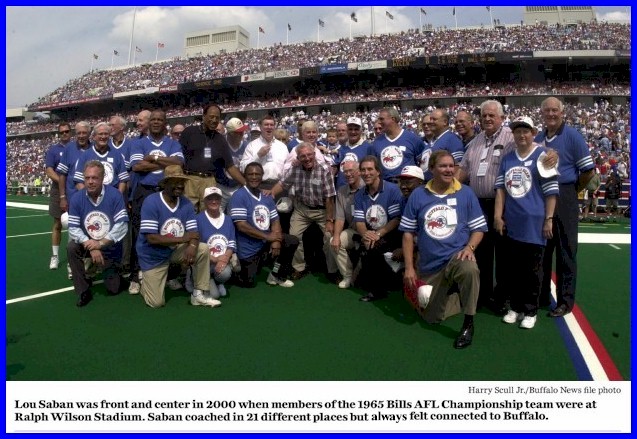 |
|
|
The Bills haven’t made it official yet, but plans are in the works
for a ceremony to commemorate the 1964 and ’65 AFL championship
teams at the home opener against the Colts on Sept. 13 at Ralph
Wilson Stadium. The celebration will mark the 50th anniversary of the Bills’ second AFL title. The team waited a year to hold the event, partly because of the change in ownership after Wilson’s death and because they wanted to honor all the players from both of Buffalo’s only major professional sports champions. This is a wonderful idea, and one that would be even better if the Bills added a gesture that is long overdue – adding Lou Saban, the coach of those title teams, and Cookie Gilchrist, the team’s first superstar, to the stadium’s Wall of Fame. “I think it would be wonderful,” said Barbara Saban, Lou’s daughter. “How do you celebrate those players if you don’t celebrate their coach at the same time? Seeing their coach up there is validation for all those guys who will never see their names up on that wall. I think the City of Buffalo would be thrilled.” Saban, a psychotherapist in Colorado, said she said sent two letters to Terry Pegula, but didn’t get a response. Ange Coniglio, a long-time AFL archivist who has a website called RemembertheAFL and a Facebook page, Bills of the Sixties, said he sent a letter to the owner and cc’d to Rex Ryan, but also heard nothing back. Evidently, someone at One Bills Drive got the message. A Bills source said the team has reconsidered its plan not to put anyone on the Wall this season and will convene a special meeting of a revamped Wall of Fame committee during training camp to vote on possible additions. That would almost surely include Saban and Gilchrist, two iconic figures from the Bills’ early days who have been left off the Wall since its inceptions for reasons that have nothing to do with their contributions on the football field. Saban won two AFL titles and turned a bad team around when he returned in 1972. But he quit twice, after winning in ’65 and five games in the 1976 season. Wilson, who sat on the committee, never forgave Saban for quitting twice. He said Saban failed to meet his loyalty standard and would never go on the Wall during his lifetime. Gilchrist was actually honored on the Bills’ now-defunct “Wall of Honor” in 1970. He was the first player selected and came to Buffalo for a ceremony, where he received a plaque. But the Wall of Honor never really took off and faded away. Wilson had his issues with Gilchrist, a proud, intelligent and often difficult man, a self-described “iconoclast.” He was named the AFL’s MVP in 1962 and led the AFL in rushing in the ’64 title year. But Wilson was so weary of dealing with Gilchrist, he traded him to Denver after the season. Over the years, Wilson softened on Gilchrist. But as Cookie became increasingly erratic and unreliable, the committee decided not to vote him onto the Wall out of fear that he wouldn’t show up for the ceremony, or that he would embarrass himself by launching into one of his rambling, resentful rants. There were questions about whether Gilchrist qualified for the Wall, having played only three years with the Bills. There was supposedly a rule that said you had to be a Bill for five years to be eligible. But any rule that would keep Gilchrist off the Wall is worth modifying. About seven or eight years ago, the committee stopped voting on Saban and Gilchrist altogether. Saban died in 2009, Gilchrist in 2011, Wilson in 2014. It’s time to put old resentments to rest and honor them at the same time as the two championship teams. “I know there’s a lot of fans out there who feel the same way,” said Coniglio, who pushed hard for the NFL to celebrate the 50th anniversary of the AFL in 2009. “There’s new ownership. This is something that can bring the community and team together. Booker Edgerson, Ed Rutkowski, my friend Ernie Warlick who died last year ... “These people aren’t going to last forever. Let’s do it while they’re around, and honor the team and honor two of the biggest components of those teams.” Saban was football’s restless itinerant, a man who coached in 21 places over 52 years. Saban coached in high school, at big and small colleges, in the arena leagues. Until his death, he gave long-distance coaching tips to his grandson, Jay, a high school coach in Denver. “My dad was no saint,” Barbara Saban said. “But for crying out loud. For the people of Buffalo and for his teams, the ’64-65 teams, Dad did right. He did right by those guys. Talking to those men at Dad’s memorial service, I found he had done things for those guys that we never knew about. Dad would go above and beyond for his players.” I spoke with Saban once, after Marv Levy became Bills general manager at age 80 in 2006. Saban was 84, but out of coaching for only three years. He felt he could come back and coach, and he had fond memories of Buffalo. He said he held no ill feelings toward Wilson, whom he considered a good football man. The late Larry Felser revered Saban and Gilchrist. Larry and Jack Kemp both called Gilchrist the greatest all-around football player they ever saw. Felser kept in touch with Saban through the years and visited him in Tampa before the Bills’ first Super Bowl. Larry walked in Saban’s house and saw two sculpted Bisons above the TV set, a cushion with a Bills’ logo on it, and a coffee mug with an old Courier-Express story about O.J. Simpson going over the 2,000-yard rushing mark in 1973. “For all the football jobs he’s held, for all the cities in which he’s worked, Saban never got the Bills or Buffalo out of his blood,” Felser wrote in 1991. Twenty-four years later, Saban’s daughter agreed. She said Lou’s time with the Bills was extremely dear to him, and that he felt a powerful bond with the people of Buffalo. He understood the town’s essential blue-collar ethos. “Oh, absolutely,” Barbara Saban said. “It meant a great deal to him, because Dad was a real working-class kind of guy at heart. He understood what it was like to work those steel mills, to live that hardscrabble kind of life. He knew what it meant to work hard to provide for your family bring home that paycheck. “He grew up poor. Dad went to work when he was 8 years old. He worked in the gravel pits outside Chicago. Eight years old. He was the guy that ran the dynamite lines into the gravel pits. Then lit the fuse and ran out. Which of course in these days would be child abuse. But that’s what you did in the Depression.” Yes, at heart, Saban was a Buffalo guy. He would have appreciated it when Rex Ryan mentioned Cookie and the old AFL days in the Rockpile during his introductory press conference at the Ralph in January. When he talked about the connection between the team and the community, you realized that Ryan gets it. Terry Pegula seems to get it, too. He cried when he saw Gil Perreault on his first day in town. He cried at his first press conference as Bills owner talking about going to see football games as a little boy. Pegula has forged a strong connection with the town. He must understand what Saban and Gilchrist mean to fans here. So this should be no-brainer. Just imagine, a ceremony to honor the Bills’ two AFL championship teams at the season opener, with Lou and Cookie finally going onto the Wall of Fame, with the living players from those two teams looking on proudly. There wouldn’t be a dry eye in the house, including the owner. email: jsullivan@buffnews.com |
|
|
Jerry Sullivan's commentaries appear regularly on the Sports pages of the Buffalo News |
|
. |
The Buffalo Bills Alumni Foundation held a great celebration of the 50th Anniversary of the Bills' AFL Championship teams. Click HERE for the Alumni press release. This was an Alumni affair. Not a word out of the Bills' management about honoring the teams until a week before the event. Then they held a short ceremony at halftime of the opening 2015 game against the Indianapolis Colts. They couldn't figure out that maybe they should have do ne it when the Bills played a former AFL opponent. No memorabilia honoring the AFL Champions was offered by the NFL or the Bills management. They did, at long last, add iconic head coach Lou Saban to their Wall of Fame (click here). The Alumni Gala was a marvelous event. In attendance were many former Bills, including the guests of honor from the 1964 and 1965 American Football League Champions: Stew Barber, George Flint, Mike Stratton, Ron McDole, Ed Rutkowski, Al Bemiller, Harry Jacobs, Billy Shaw, Booker Edgerson, Glenn Bass, Willie Ross, Daryle Lamonica, Butch Byrd, Paul Maguire, Charlie Ferguson, Wray Carlton, Bobby Smith, long-time trainer Ed Abramoski, and the families of the late Tom Day, Jack Kemp, Ernie Warlick, Cookie Gilchrist and Lou Saban. Click the image below for a video of the gala, by former player Jeff Nixon (Bills 1979 - 1984). . |
|
|
.. |
| For more images from the Alumni Gala and photos of the Bills and their children, go to Children of CHAMPIONS. |
.. |
|
||||||||||||||
|
||||||||||||||
. |
.. |
.. |
 |
|
|
 |
|
|
|
| Site Index |
AFL Guest Book |
Bills History | Bills Alumni | 1964 AFL Champions |
Players
who Belong in the Hall of Fame |
|
| . | ||||||
|
©2003
American Football
League Hall of Fame All rights reserved. Duplicate in any form you
like, if you're an AFL fan. You have the permission of the American Football League Hall of Fame. Please credit/link to: http://www.remembertheafl.com Last revision: 19 December 2024 ~ Angelo F. Coniglio, nospam.RemembertheAFL@aol.com |
||||||